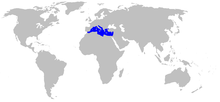Posidonia oceanica
| Posidonia oceanica | |
|---|---|
 |
|
| Scientific classification | |
| Kingdom: | Plantae |
| (unranked): | Angiosperms |
| (unranked): | Monocots |
| Order: | Alismatales |
| Family: | Posidoniaceae |
| Genus: | Posidonia |
| Species: | P. oceanica |
| Binomial name | |
|
Posidonia oceanica (L.) Delile |
|
 |
|
| Posidonia oceanica range | |
Posidonia oceanica (commonly known as Neptune Grass or Mediterranean tapeweed) is a seagrass species that is endemic to the Mediterranean Sea. It forms large underwater meadows that are an important part of the ecosystem. The fruit is free floating and known in Italy as "the olive of the sea" (l'oliva di mare). Balls of fibrous material from its foliage, known as egagropili, wash up to nearby shorelines.
P. oceanica is a flowering plant which lives in dense meadows or along channels in the sands of the Mediterranean. It is found at depths from 1–35 metres (3.3–114.8 ft), according to water clarity. Subsurface rhizomes and roots stabilize the plant while erect rhizomes and leaves reduce silt accumulation.
The leaves are ribbon-like, appearing in tufts of 6 or 7, and up to 1.5 metres (4.9 ft) long. Average leaf width is around 10 millimetres (0.39 in). The leaves are bright green, perhaps turning brown with age, and have 13 to 17 parallel veins. The leaf terminus is rounded or sometimes absent because of damage. Leaves are arranged in groups, with older leaves on the outside, longer and differing in form from the younger leaves they surround.
The rhizome type stems are found in two forms: one growing up to 150 centimetres (59 in) beneath the sand and the other rising above the sand. All stems are approximately 10 millimetres (0.39 in) thick and upright in habit. This arrangement of the rhizomes eventually forms a ; the surface contains the active parts of the plant, whereas the center is a dense network of roots and decomposing stems.
The flowering plant's common name is Neptune grass. In 2006 a huge clonal colony of P. oceanica was discovered south of the island of Ibiza. At 8 kilometres (5.0 mi) across, and estimated at around 100,000 years old, it may be one of the largest and oldest clonal colonies on Earth.
This species is found only in the Mediterranean Sea where it is in decline, occupying an area of only about 3% of the basin. This corresponds to a surface area of about 38,000 square kilometres (15,000 sq mi). Posidonia grows best in clean waters, and its presence is a marker for lack of pollution. The presence of Posidonia can be detected by the masses of decomposing leaves on beaches. Such plant material has been used for composting, but Italian laws prohibit the use of marine algae and plants for this purpose.
...
Wikipedia

